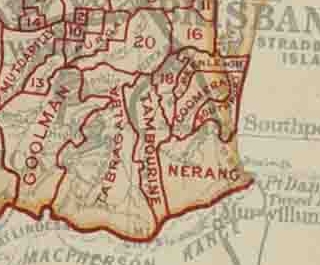1884 to 1902


In 1862, the Lahey family emigrated from Ireland with eleven children. In 1875, Francis Lahey purchased a sugar mill at Tygum near Waterford for his sons, later expanding operations to include sawmilling. From immersion within this industry, son David Lahey commenced construction of the Canungra Sawmill on 2 October 1884. In the same year, Francis’s children of David, John, Isaiah, Thomas and Evangeline Lahey were granted selections of land around Canungra (meaning ‘Place Of Night Owl or Small Grey Owl’) totaling over 3,000 acres. (Early timber harvesting commenced in the 1860s by Hugh Mahony who cut and hauled cedar logs to mills in Ipswich.)
After connection of the Beaudesert railway section from Bethania to Logan Village on 21 September 1885, the residents of Tamborine, began to lobby the government for their connection. In response, Surveyor for Queensland Rail, George Phillips, surveyed a nine mile route to the township of Tambourine, determining that the main expense to overcome would be installation of a bridge over the Albert River. (Phillips had a passion for extending railways throughout Queensland and invented and patented in 1884 a steel railway sleeper that could be used where floods and termites made normal railway track was less viable. During 1902/03 he supervised construction of the Beaudesert Tramway and years later he wrote a book on flood mitigation in the Brisbane River. He also became a member of the Qld Legislative Assembly.)
The flood of 1887 washed away the first Tambourine Hotel afterwhich a second hotel and a hall was built up near Tambourine Logan Village Road on the Yore property. The Logan Village to Beaudesert railway section opened on 16 May 1888.
In 1888, Thomas Plunkett nominated as a candidate for parliament and represented the Albert Electorate for eight years before being defeated by local rival Robert Martin Collins, son of John Collins and his wife Anne, née Martin, of Mundoolun Station.
The Laheys ultimately acquired timber leases amounting to over 16,000 acres (6,500 ha) in the Canungra and Pine Creek Valley of Coomera, thereby requiring slow and expensive bullock teams to haul logs over ever-increasing distances to the mill. In 1890, the Laheys decided to build a tramway into the Pine Creek Valley to help keep transportation costs down, which was surveyed by George Phillips once again. On 9 July 1897, the Canungra mill burnt down.
As the Tabragalba Division was created on 11 November 1879, so was it separated on 4 October 1890 to establish the Tambourine Division. Due to the local roads being “in many instances dangerous and impassable”, and the existing Tabragalba Division maintaining “too tighter control” in the area, in hope to try to have either a better road or a railway built to Canungra, the Laheys signed a petition in favour of creation of the new Tambourine Divisional Board as administrative centre for the Tambourine Local Government Division which included “Messrs. De Burgh Persse, M.L.A., Collins, Delpratt, White, Hinchcliffe, Plunkett, JJ.P., Massie, Yore, Walsh, Ryan, Drynan, Kelso, Flanagan, Seymour, and others” attending the meetings. (As noted in a historical newspaper as a published record of a meeting.)
The Federation Drought commenced in 1895 which severely affected the farming region.
At a Saturday night meeting at the Tambourine Hotel in 1895, the Tambourine Jockey Club was formed on the property of Michael Yore. ‘Ardee’ House was purchased to breed blood horses.
On 14 March 1901 an informal poll on the proposed borrowing of £21,000 by the Tambourine Divisional Board to construct a line from Logan Village to Tambourine Station was conducted and the Lahey Sawmill company offered to lease this railway for forty years.
Lahey’s Canungra Tramway was then built from 1901 to 1903 by Mr Clark. The Canungra Tramway Tunnel was formed, piercing through to the other side, at 91 metres in length, by John W Lahey on
1 January 1901, with first use of the tunnel being in September 1903. St John’s Anglican Church at Mundoolun was built from 1901 to 1915.
Thomas Plunkett returned as electorate representative in 1902 (and again in 1904 and 1907), and the formation of the Shire of Tambourine started to evolve changing the region forever.
